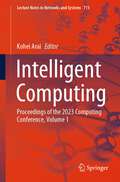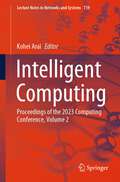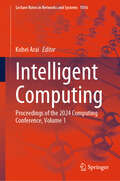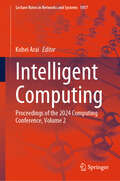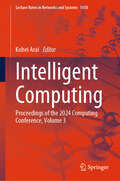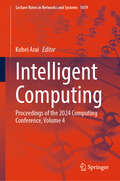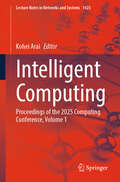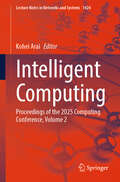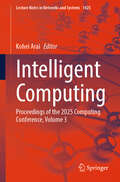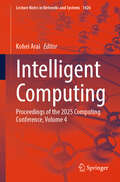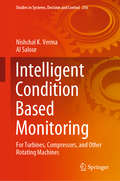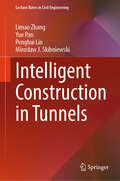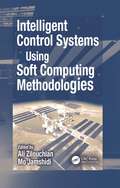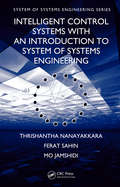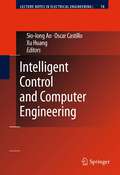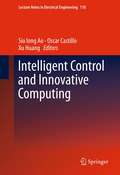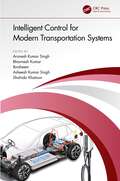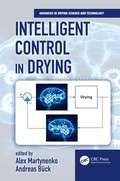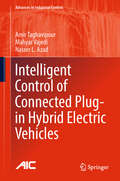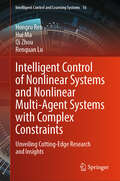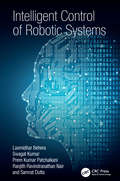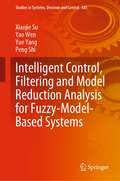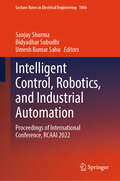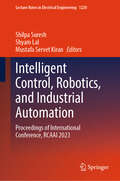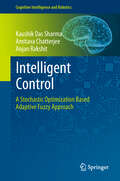- Table View
- List View
Intelligent Computing: Proceedings of the 2023 Computing Conference, Volume 1 (Lecture Notes in Networks and Systems #711)
by Kohei AraiThis book is a collection of insightful and unique state-of the-art papers presented at the Computing Conference which took place in London on June 22–23, 2023. A total of 539 papers were received out of which 193 were selected for presenting after double-blind peer-review. The book covers a wide range of scientific topics including IoT, Artificial Intelligence, Computing, Data Science, Networking, Data security and Privacy, etc. The conference was successful in reaping the advantages of both online and offline modes. The goal of this conference is to give a platform to researchers with fundamental contributions and to be a premier venue for academic and industry practitioners to share new ideas and development experiences. We hope that readers find this book interesting and valuable. We also expect that the conference and its publications will be a trigger for further related research and technology improvements in this important subject.
Intelligent Computing: Proceedings of the 2023 Computing Conference, Volume 2 (Lecture Notes in Networks and Systems #739)
by Kohei AraiThis book is a collection of extremely well-articulated, insightful and unique state-ofthe-art papers presented at the Computing Conference which took place in London on June 22–23, 2023. A total of 539 papers were received out of which 193 were selected for presenting after double-blind peer-review. The book covers a wide range of scientific topics including IoT, Artificial Intelligence, Computing, Data Science, Networking, Data security and Privacy, etc. The conference was successful in reaping the advantages of both online and offline modes. The goal of this conference is to give a platform to researchers with fundamental contributions and to be a premier venue for academic and industry practitioners to share new ideas and development experiences. We hope that readers find this book interesting and valuable. We also expect that the conference and its publications will be a trigger for further related research and technology improvements in this important subject.
Intelligent Computing: Proceedings of the 2024 Computing Conference, Volume 1 (Lecture Notes in Networks and Systems #1016)
by Kohei AraiExplore the forefront of computing with the proceedings of the Computing Conference 2024. Featuring 165 carefully selected papers from a pool of 457 submissions, this collection encapsulates the cutting-edge research and innovation presented during the conference. Delve into a diverse range of topics, insights, and methodologies that shape the future of computing. Whether you're an academic, researcher, or enthusiast, this concise volume offers a snapshot of the dynamic and collaborative spirit defining the Computing Conference 2024.
Intelligent Computing: Proceedings of the 2024 Computing Conference, Volume 2 (Lecture Notes in Networks and Systems #1017)
by Kohei AraiExplore the forefront of computing with the proceedings of the Computing Conference 2024. Featuring 165 carefully selected papers from a pool of 457 submissions, this collection encapsulates the cutting-edge research and innovation presented during the conference. Delve into a diverse range of topics, insights, and methodologies that shape the future of computing. Whether you're an academic, researcher, or enthusiast, this concise volume offers a snapshot of the dynamic and collaborative spirit defining the Computing Conference 2024.
Intelligent Computing: Proceedings of the 2024 Computing Conference, Volume 3 (Lecture Notes in Networks and Systems #1018)
by Kohei AraiExplore the forefront of computing with the proceedings of the Computing Conference 2024. Featuring 165 carefully selected papers from a pool of 457 submissions, this collection encapsulates the cutting-edge research and innovation presented during the conference. Delve into a diverse range of topics, insights, and methodologies that shape the future of computing. Whether you're an academic, researcher, or enthusiast, this concise volume offers a snapshot of the dynamic and collaborative spirit defining the Computing Conference 2024.
Intelligent Computing: Proceedings of the 2024 Computing Conference, Volume 4 (Lecture Notes in Networks and Systems #1019)
by Kohei AraiExplore the forefront of computing with the proceedings of the Computing Conference 2024. Featuring 165 carefully selected papers from a pool of 457 submissions, this collection encapsulates the cutting-edge research and innovation presented during the conference. Delve into a diverse range of topics, insights, and methodologies that shape the future of computing. Whether you're an academic, researcher, or enthusiast, this concise volume offers a snapshot of the dynamic and collaborative spirit defining the Computing Conference 2024.
Intelligent Computing: Proceedings of the 2025 Computing Conference, Volume 1 (Lecture Notes in Networks and Systems #1423)
by Kohei AraiThis book compiles a curated selection of insightful, rigorously researched, and state-of-the-art papers presented at the Computing Conference 2025, hosted in London, UK, on June 19–20, 2025. Drawing submissions from across the globe, the conference received 473 papers, each subjected to a stringent double-blind peer-review process. Of these, 169 papers were accepted for inclusion, reflecting exceptional scholarship and innovation across disciplines such as IoT, artificial intelligence, computing, data science, networking, data security, and privacy. Researchers, academics, and industry leaders converged to share pioneering ideas, transformative methodologies, and practical solutions to real-world challenges. By bridging academic theory and industrial application, the conference catalyzed opportunities for knowledge synthesis and interdisciplinary progress. The diverse contributions within this proceedings not only address contemporary technological issues but also anticipate future trends, offering frameworks for continued exploration. We trust this collection will serve as an indispensable reference for researchers, practitioners, and policymakers navigating the evolving landscapes of computing and digital innovation. As we reflect on the conference&’s outcomes, we are confident that the insights and collaborations forged here will inspire sustained advancements in these critical fields. May the ideas within these pages spark further inquiry, drive technological evolution, and contribute meaningfully to solving the challenges of our interconnected world.
Intelligent Computing: Proceedings of the 2025 Computing Conference, Volume 2 (Lecture Notes in Networks and Systems #1424)
by Kohei AraiThis book compiles a curated selection of insightful, rigorously researched, and state-of-the-art papers presented at the Computing Conference 2025, hosted in London, UK, on June 19–20, 2025. Drawing submissions from across the globe, the conference received 473 papers, each subjected to a stringent double-blind peer-review process. Of these, 169 papers were accepted for inclusion, reflecting exceptional scholarship and innovation across disciplines such as IoT, artificial intelligence, computing, data science, networking, data security, and privacy. Researchers, academics, and industry leaders converged to share pioneering ideas, transformative methodologies, and practical solutions to real-world challenges. By bridging academic theory and industrial application, the conference catalyzed opportunities for knowledge synthesis and interdisciplinary progress. The diverse contributions within this proceedings not only address contemporary technological issues but also anticipate future trends, offering frameworks for continued exploration. We trust this collection will serve as an indispensable reference for researchers, practitioners, and policymakers navigating the evolving landscapes of computing and digital innovation. As we reflect on the conference&’s outcomes, we are confident that the insights and collaborations forged here will inspire sustained advancements in these critical fields. May the ideas within these pages spark further inquiry, drive technological evolution, and contribute meaningfully to solving the challenges of our interconnected world.
Intelligent Computing: Proceedings of the 2025 Computing Conference, Volume 3 (Lecture Notes in Networks and Systems #1425)
by Kohei AraiThis book compiles a curated selection of insightful, rigorously researched, and state-of-the-art papers presented at the Computing Conference 2025, hosted in London, UK, on June 19–20, 2025. Drawing submissions from across the globe, the conference received 473 papers, each subjected to a stringent double-blind peer-review process. Of these, 169 papers were accepted for inclusion, reflecting exceptional scholarship and innovation across disciplines such as IoT, artificial intelligence, computing, data science, networking, data security, and privacy. Researchers, academics, and industry leaders converged to share pioneering ideas, transformative methodologies, and practical solutions to real-world challenges. By bridging academic theory and industrial application, the conference catalyzed opportunities for knowledge synthesis and interdisciplinary progress. The diverse contributions within this proceedings not only address contemporary technological issues but also anticipate future trends, offering frameworks for continued exploration. We trust this collection will serve as an indispensable reference for researchers, practitioners, and policymakers navigating the evolving landscapes of computing and digital innovation. As we reflect on the conference&’s outcomes, we are confident that the insights and collaborations forged here will inspire sustained advancements in these critical fields. May the ideas within these pages spark further inquiry, drive technological evolution, and contribute meaningfully to solving the challenges of our interconnected world.
Intelligent Computing: Proceedings of the 2025 Computing Conference, Volume 4 (Lecture Notes in Networks and Systems #1426)
by Kohei AraiThis book compiles a curated selection of insightful, rigorously researched, and state-of-the-art papers presented at the Computing Conference 2025, hosted in London, UK, on June 19–20, 2025. Drawing submissions from across the globe, the conference received 473 papers, each subjected to a stringent double-blind peer-review process. Of these, 169 papers were accepted for inclusion, reflecting exceptional scholarship and innovation across disciplines such as IoT, artificial intelligence, computing, data science, networking, data security, and privacy. Researchers, academics, and industry leaders converged to share pioneering ideas, transformative methodologies, and practical solutions to real-world challenges. By bridging academic theory and industrial application, the conference catalyzed opportunities for knowledge synthesis and interdisciplinary progress. The diverse contributions within this proceedings not only address contemporary technological issues but also anticipate future trends, offering frameworks for continued exploration. We trust this collection will serve as an indispensable reference for researchers, practitioners, and policymakers navigating the evolving landscapes of computing and digital innovation. As we reflect on the conference&’s outcomes, we are confident that the insights and collaborations forged here will inspire sustained advancements in these critical fields. May the ideas within these pages spark further inquiry, drive technological evolution, and contribute meaningfully to solving the challenges of our interconnected world.
Intelligent Condition Based Monitoring: For Turbines, Compressors, and Other Rotating Machines (Studies in Systems, Decision and Control #256)
by Nishchal K. Verma Al SalourThis book discusses condition based monitoring of rotating machines using intelligent adaptive systems. The book employs computational intelligence and fuzzy control principles to deliver a module that can adaptively monitor and optimize machine health and performance. This book covers design and performance of such systems and provides case studies and data models for fault detection and diagnosis. The contents cover everything from optimal sensor positioning to fault diagnosis. The principles laid out in this book can be applied across rotating machinery such as turbines, compressors, and aircraft engines. The adaptive fault diagnostics systems presented can be used in multiple time and safety critical applications in domains such as aerospace, automotive, deep earth and deep water exploration, and energy.
Intelligent Construction in Tunnels (Lecture Notes in Civil Engineering #679)
by Limao Zhang Yue Pan Mirosław J. Skibniewski Penghui LinThis book highlights the latest technologies and applications of intelligent construction in the domain of tunneling works. Rapid urbanization has surged the rapid development of underground infrastructures in major metropolitans around the world over the past decades. The development of urban tunnel systems is a challenging task with high complexity in terms of design, construction, and maintenance. Recent advancements in information and communication technologies (ICTs) have driven vast transformations around the world with successful implementations in many domains of science. Under the concept of &“industry 4.0&”, there are many attempts at intelligent construction using the latest ICTs, where the major applications in urban system development mainly focus on building information modelling (BIM), Internet of Things (IoT), deep learning, and computer vision. A tremendous transformation has taken place in the past years with the emerging intelligent construction applications in urban tunnel development. This enables industrial participants to operate projects more efficiently and safely, not only increasing the automation and productivity in tunnel development but also enhancing construction competitiveness globally.
Intelligent Control Systems Using Soft Computing Methodologies
by Mo Jamshidi Ali ZilouchianIn recent years, intelligent control has emerged as one of the most active and fruitful areas of research and development. Until now, however, there has been no comprehensive text that explores the subject with focus on the design and analysis of biological and industrial applications. Intelligent Control Systems Using Soft Computing Methodologies does all that and more.Beginning with an overview of intelligent control methodologies, the contributors present the fundamentals of neural networks, supervised and unsupervised learning, and recurrent networks. They address various implementation issues, then explore design and verification of neural networks for a variety of applications, including medicine, biology, digital signal processing, object recognition, computer networking, desalination technology, and oil refinery and chemical processes.The focus then shifts to fuzzy logic, with a review of the fundamental and theoretical aspects, discussion of implementation issues, and examples of applications, including control of autonomous underwater vehicles, navigation of space vehicles, image processing, robotics, and energy management systems. The book concludes with the integration of genetic algorithms into the paradigm of soft computing methodologies, including several more industrial examples, implementation issues, and open problems and open problems related to intelligent control technology.Suitable as a textbook or a reference, Intelligent Control Systems explores recent advances in the field from both the theoretical and the practical viewpoints. It also integrates intelligent control design methodologies to give designers a set of flexible, robust controllers and provide students with a tool for solving the examples and exercises within the book.
Intelligent Control Systems with an Introduction to System of Systems Engineering
by Thrishantha Nanayakkara Mo Jamshidi Ferat SahinFrom aeronautics and manufacturing to healthcare and disaster management, systems engineering (SE) now focuses on designing applications that ensure performance optimization, robustness, and reliability while combining an emerging group of heterogeneous systems to realize a common goal. Use SoS to Revolutionize Management of Large Organizations, Factories, and Systems Intelligent Control Systems with an Introduction to System of Systems Engineering integrates the fundamentals of artificial intelligence and systems control in a framework applicable to both simple dynamic systems and large-scale system of systems (SoS). For decades, NASA has used SoS methods, and major manufacturers—including Boeing, Lockheed-Martin, Northrop-Grumman, Raytheon, BAE Systems—now make large-scale systems integration and SoS a key part of their business strategies, dedicating entire business units to this remarkably efficient approach.Simulate Novel Robotic Systems and ApplicationsTranscending theory, this book offers a complete and practical review of SoS and some of its fascinating applications, including: Manipulation of robots through neural-based network control Use of robotic swarms, based on ant colonies, to detect mines Other novel systems in which intelligent robots, trained animals, and humans cooperate to achieve humanitarian objectives Training engineers to integrate traditional systems control theory with soft computing techniques further nourishes emerging SoS technology. With this in mind, the authors address the fundamental precepts at the core of SoS, which uses human heuristics to model complex systems, providing a scientific rationale for integrating independent, complex systems into a single coordinated, stabilized, and optimized one. They provide readers with MATLAB® code, which can be downloaded from the publisher's website to simulate presented results and projects that offer practical, hands-on experience using concepts discussed throughout the book.
Intelligent Control and Computer Engineering
by He Huang Sio-Iong Ao Oscar CastilloA large international conference on Advances in Intelligent Control and Computer Engineering was held in Hong Kong, March 17-19, 2010, under the auspices of the International MultiConference of Engineers and Computer Scientists (IMECS 2010). The IMECS is organized by the International Association of Engineers (IAENG). Intelligent Control and Computer Engineering contains 25 revised and extended research articles written by prominent researchers participating in the conference. Topics covered include artificial intelligence, control engineering, decision supporting systems, automated planning, automation systems, systems identification, modelling and simulation, communication systems, signal processing, and industrial applications. Intelligent Control and Computer Engineering offers the state of the art of tremendous advances in intelligent control and computer engineering and also serves as an excellent reference text for researchers and graduate students, working on intelligent control and computer engineering.
Intelligent Control and Innovative Computing (Lecture Notes in Electrical Engineering #110)
by He Huang Sio Iong Ao Oscar CastilloA large international conference on Advances in Intelligent Control and Innovative Computing was held in Hong Kong, March March 16-18, 2011, under the auspices of the International MultiConference of Engineers and Computer Scientists (IMECS 2010). The IMECS is organized by the International Association of Engineers (IAENG). Intelligent Control and Computer Engineering contains 25 revised and extended research articles written by prominent researchers participating in the conference. Topics covered include artificial intelligence, control engineering, decision supporting systems, automated planning, automation systems, systems identification, modelling and simulation, communication systems, signal processing, and industrial applications. Intelligent Control and Innovative Computing offers the state of the art of tremendous advances in intelligent control and computer engineering and also serves as an excellent reference text for researchers and graduate students, working on intelligent control and computer engineering.
Intelligent Control for Modern Transportation Systems
by Bhavnesh Kumar Arunesh Kumar Singh Ibraheem Asheesh Kumar Singh Shahida KhatoonThe book comprehensively discusses concepts of artificial intelligence in green transportation systems. It further covers intelligent techniques for precise modeling of complex transportation infrastructure, forecasting and predicting traffic congestion, and intelligent control techniques for maximizing performance and safety. It further provides MATLAB® programs for artificial intelligence techniques. It discusses artificial intelligence-based approaches and technologies in controlling and operating solar photovoltaic systems to generate power for electric vehicles. Highlights how different technological advancements have revolutionized the transportation system. Presents core concepts and principles of soft computing techniques in the control and management of modern transportation systems. Discusses important topics such as speed control, fuel control challenges, transport infrastructure modeling, and safety analysis. Showcases MATLAB® programs for artificial intelligence techniques. Discusses roles, implementation, and approaches of different intelligent techniques in the field of transportation systems. It will serve as an ideal text for professionals, graduate students, and academicians in the fields of electrical engineering, electronics and communication engineering, civil engineering, and computer engineering.
Intelligent Control in Drying (Advances in Drying Science and Technology)
by Alex Martynenko and Andreas BückDespite the available general literature in intelligent control, there is a definite lack of knowledge and know-how in practical applications of intelligent control in drying. This book fills that gap. Intelligent Control in Drying serves as an innovative and practical guide for researchers and professionals in the field of drying technologies, providing an overview of control principles and systems used in drying operations, from classical to model-based to adaptive and optimal control. At the same time, it lays out approaches to synthesis of control systems, based on the objectives and control strategies, reflecting complexity of drying process and material under drying. This essential reference covers both fundamental and practical aspects of intelligent control, sensor fusion and dynamic optimization with respect to drying.
Intelligent Control of Connected Plug-in Hybrid Electric Vehicles (Advances in Industrial Control)
by Amir Taghavipour Mahyar Vajedi Nasser L. AzadIntelligent Control of Connected Plug-in Hybrid Electric Vehicles presents the development of real-time intelligent control systems for plug-in hybrid electric vehicles, which involves control-oriented modelling, controller design, and performance evaluation. The controllers outlined in the book take advantage of advances in vehicle communications technologies, such as global positioning systems, intelligent transportation systems, geographic information systems, and other on-board sensors, in order to provide look-ahead trip data. The book contains simple and efficient models and fast optimization algorithms for the devised controllers to address the challenge of real-time implementation in the design of complex control systems. Using the look-ahead trip information, the authors of the book propose intelligent optimal model-based control systems to minimize the total energy cost, for both grid-derived electricity and fuel. The multilayer intelligent control system proposed consists of trip planning, an ecological cruise controller, and a route-based energy management system. An algorithm that is designed to take advantage of previewed trip information to optimize battery depletion profiles is presented in the book. Different control strategies are compared and ways in which connecting vehicles via vehicle-to-vehicle communication can improve system performance are detailed. Intelligent Control of Connected Plug-in Hybrid Electric Vehicles is a useful source of information for postgraduate students and researchers in academic institutions participating in automotive research activities. Engineers and designers working in research and development for automotive companies will also find this book of interest.Advances in Industrial Control reports and encourages the transfer of technology in control engineering. The rapid development of control technology has an impact on all areas of the control discipline. The series offers an opportunity for researchers to present an extended exposition of new work in all aspects of industrial control.
Intelligent Control of Nonlinear Systems and Nonlinear Multi-Agent Systems with Complex Constraints: Unveiling Cutting-Edge Research and Insights (Intelligent Control and Learning Systems #16)
by Qi Zhou Hui Ma Renquan Lu Hongru RenThis book proposes an integrated design method for intelligent adaptive controllers to overcome the negative effects of various constraints on nonlinear systems and nonlinear multiagent systems in practical applications. The book rigorously provides problem analysis, controller design, and stability theory. In addition, numerous simulation examples are given to demonstrate the validity of the corresponding intelligent control methods, and the simulation results are illustrated in detail with graphs and tables. The methods proposed in this book eliminate some limitations of existing control methods in nonlinear systems and nonlinear multiagent systems with complex constraints and broaden the practical applications of intelligent control methods in industrial automation.
Intelligent Control of Robotic Systems
by Laxmidhar Behera Swagat Kumar Prem Kumar Patchaikani Ranjith Ravindranathan Nair Samrat DuttaThis book illustrates basic principles, along with the development of the advanced algorithms, to realize smart robotic systems. It speaks to strategies by which a robot (manipulators, mobile robot, quadrotor) can learn its own kinematics and dynamics from data. In this context, two major issues have been dealt with; namely, stability of the systems and experimental validations. Learning algorithms and techniques as covered in this book easily extend to other robotic systems as well. The book contains MATLAB- based examples and c-codes under robot operating systems (ROS) for experimental validation so that readers can replicate these algorithms in robotics platforms.
Intelligent Control, Filtering and Model Reduction Analysis for Fuzzy-Model-Based Systems (Studies in Systems, Decision and Control #385)
by Xiaojie Su Peng Shi Yao Wen Yue YangThis book aims to introduce the state-of-the-art research of stability/performance analysis and optimal synthesis methods for fuzzy-model-based systems. A series of problems are solved with new approaches of design, analysis and synthesis of fuzzy systems, including stabilization control and stability analysis, dynamic output feedback control, fault detection filter design, and reduced-order model approximation. Some efficient techniques, such as Lyapunov stability theory, linear matrix inequality, reciprocally convex approach, and cone complementary linearization method, are utilized in the approaches. This book is a comprehensive reference for researchers and practitioners working on intelligent control, model reduction, and fault detection of fuzzy systems, and is also a useful source of information for senior undergraduates and graduates in these areas. The readers will benefit from some new concepts and methodologies with theoretical and practical significance in system analysis and control synthesis.
Intelligent Control, Robotics, and Industrial Automation: Proceedings of International Conference, RCAAI 2022 (Lecture Notes in Electrical Engineering #1066)
by Sanjay Sharma Bidyadhar Subudhi Umesh Kumar SahuThis volume comprises peer-reviewed proceedings of the International Conference on Robotics, Control, Automation, and Artificial Intelligence (RCAAI 2022). It aims to provide a broad spectrum picture of the state of art research and development in the areas of intelligent control, the Internet of Things, machine vision, cybersecurity, robotics, circuits, and sensors, among others. This volume will provide a valuable resource for those in academia and industry.
Intelligent Control, Robotics, and Industrial Automation: Proceedings of International Conference, RCAAI 2023 (Lecture Notes in Electrical Engineering #1220)
by Shilpa Suresh Shyam Lal Mustafa Servet KiranThis volume comprises peer-reviewed proceedings of the International Conference on Robotics, Control, Automation, and Artificial Intelligence (RCAAI 2023). It aims to provide a broad spectrum picture of the state of art research and development in the areas of intelligent control, the Internet of Things, machine vision, cybersecurity, robotics, circuits, and sensors, among others. This volume will provide a valuable resource for those in academia and industry.
Intelligent Control: A Stochastic Optimization Based Adaptive Fuzzy Approach (Cognitive Intelligence and Robotics)
by Amitava Chatterjee Kaushik Das Sharma Anjan RakshitThis book discusses systematic designs of stable adaptive fuzzy logic controllers employing hybridizations of Lyapunov strategy-based approaches/H∞ theory-based approaches and contemporary stochastic optimization techniques. The text demonstrates how candidate stochastic optimization techniques like Particle swarm optimization (PSO), harmony search (HS) algorithms, covariance matrix adaptation (CMA) etc. can be utilized in conjunction with the Lyapunov theory/H∞ theory to develop such hybrid control strategies. The goal of developing a series of such hybridization processes is to combine the strengths of both Lyapunov theory/H∞ theory-based local search methods and stochastic optimization-based global search methods, so as to attain superior control algorithms that can simultaneously achieve desired asymptotic performance and provide improved transient responses. The book also demonstrates how these intelligent adaptive control algorithms can be effectively utilized in real-life applications such as in temperature control for air heater systems with transportation delay, vision-based navigation of mobile robots, intelligent control of robot manipulators etc.
